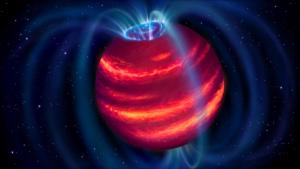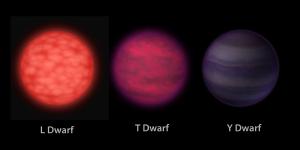Blog
As Seen on the Radio
10 November 2020
 ASTRON / Danielle Futselaar
ASTRON / Danielle FutselaarBrown dwarfs are interesting objects. They are generally defined as bodies massive enough to trigger the fusion of deuterium or lithium in their cores (and are thus not a planet) but too small to fuse hydrogen in their cores (and therefore not a star). They are the middle children of cosmic bodies.
Brown dwarfs would also be difficult to identify just to look at them. The least massive ones (Y dwarfs) are slightly larger than Jupiter, with a surface temperature of only 700 K. That’s warm, but not visibly glowing. In one case, astronomers detected the presence of clouds on a cool brown dwarf, meaning they would look very similar to Jupiter.
 NASA/JPL-Caltech
NASA/JPL-CaltechThe most massive brown dwarfs (L Dwarfs) are smaller than Jupiter. Because they have more mass, their gravity squeezes their outer gas layer more tightly so that they have are about 80% the diameter of Jupiter. They also have a surface temperature of about 2800 K, which is hot enough to emit a warm red glow. They would look like small red dwarf stars.
As you might imagine, it can be difficult to detect brown dwarfs. Most of them are identified by infrared telescopes since they can emit a great deal of heat. While that works well for the warmest brown dwarfs, it doesn’t work well for cooler ones. But recently a team discovered a brown dwarf using a radio telescope, which opens the door to a new way of finding them.1
Large planets such as Jupiter emit a tremendous amount of radio light. This is because they have strong magnetic dynamos. Their magnetic fields can trap charged particles, causing them to spiral toward the poles. These particles slam into the dwarf’s atmosphere near the poles, creating aurora similar to what we see on Earth. Since the charged particles are accelerated along the magnetic fields, they emit radio light.
 LOFAR / ASTRON
LOFAR / ASTRONSince brown dwarfs are similar to Jupiter, they also have aurora that emits radio. We’ve observed these radio emissions from brown dwarfs before. In this new study, a team used the low-frequency radio telescope known as LOFAR to capture the radio signal from a previously undiscovered brown dwarf. It is the first brown dwarf to be discovered purely by radio.
LOFAR is particularly well suited to discover brown dwarfs by radio since it is most sensitive at the low frequencies these bodies emit. The radio telescope can also detect the polarization of radio signals. Since radio emissions from magnetic fields are polarized, this allows LOFAR to pick out the radio signals of brown dwarfs and Jupiter-type planets more easily. With luck, LOFAR should be able to detect many more brown dwarfs in the near future.
Vedantham, H. K., et al. “Direct radio discovery of a cold brown dwarf.” The Astrophysical Journal Letters 903.2 (2020): L33. ↩︎